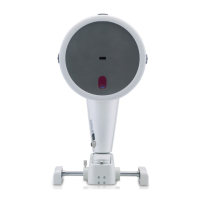14
4.2.3 Glaucoma screening
We recommend using the following maps and analysis displays:
Fast Screening Report to check whether the displayed parameters are within normal limits
General Overview display to view the chamber angle in the Scheimpflug images and corneal
thickness. While clicking to the button “Enter IOP” the tonometrically measured IOP can be
entered manually or the respective IOP change can be viewed. The displayed IOP is based on
pre-programmed IOP corrections tables. For more details refer to the Pentacam® User Guide
Important values: ACD, ACV, ACA, Q-value, QS, pachymetry, IOP-correction
4.2.4 Cataract surgery and IOL calculation for virgin and post refractive corneas
We recommend using the following maps and analysis displays
Fast Screening Report to check whether the displayed parameters are within normal limits
Cataract Pre-OP Display that offers a comprehensive overview. Prof. Maeda recommended the
4 following steps to select the IOL:
1. Evaluation of corneal irregularities
2. Corneal shape assessment
3. Evaluations of corneal spherical aberrations
4. Evaluations of the corneal astigmatism
(An article was published in „The Highlights of Ophthalmology“ Assessment of Corneal Optical
Quality for Premium IOLs with Pentacam®“ Highlights of Ophthalmology • Vol. 39, Nº 4, 2011)
Zernike Analysis to determine the amount HOA and LOA
ACD, manual horizontal white-to-white (HWTW) for keratometry readings from virgin eyes
Scheimpflug images to obtain information on the dimensions of the anterior chamber and the
condition of the crystalline lens. Lens density can be quantified in a single location, a line, an area
or a volume, as desired. The grading PNS can be used for optimizing Phaco settings (doi:10.1016/j.
jcrs.2009.08.032) and for the effective phaco time (http://dx.doi.org/10.1016/j.ajo.2013.09.017)
The Holladay Report and the Holladay EKR65 Detail Report for a comprehensive overview of the
cornea. This includes the topographic as well as the pachymetry map and the anterior and
posterior elevation maps. For more information refer to chapter 17
The BESSt formula, developed from Edmondo Borrasio, MD. This requires Rm anterior,
Rm posterior, CCT and ACD doi:10.1016/j.jcrs.2006.08.037
Okulix or Phaco Optics, which are IOL power calculation software based on the ray tracing
principle. More information can be found under: www.phacoptics.com; www.okulix.de
Important values: Keratometry, asti and axis, Q-value, QS, ACD, pachymetry in the thinnest spot
and in the pupil center
4 Recommended settings and color maps, displays and values

